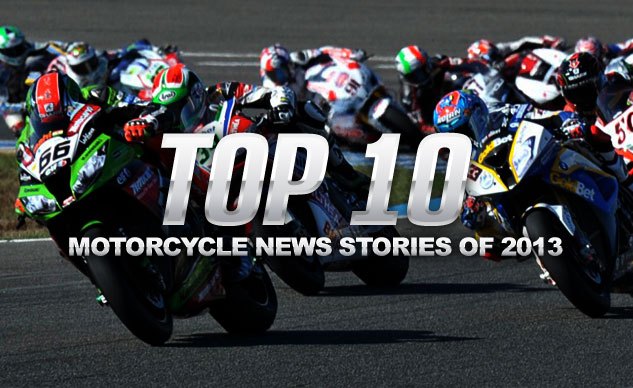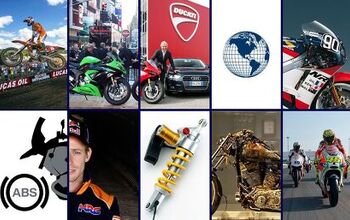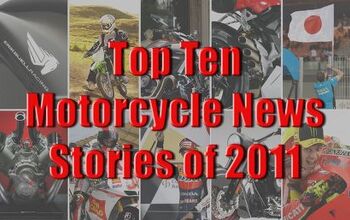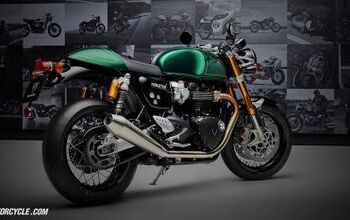Top 10 Motorcycle News Stories of 2013

A look back at the year that was
With 2014 just around the corner, it’s time to take a look back at the year that was and revisit the top news stories from the motorcycling world in 2013.
The last year saw a lot of changes in an industry that is still feeling the effects of the economic downturn. In many ways, the top stories of 2013 marked the beginning of a new era, whether it was the rebirth of an iconic brand, the coronation of a young phenom or the adoption of new technologies.
With all of these changes, one thing remains certain: 2014 will be an exciting year for the motorcycle industry.
10. Nissin ABS Recall Affects Multiple Manufacturers
Recall campaigns can be a source of bad PR for manufacturers, but sometimes a problem comes up that they have little control over. Sometimes a defect affects a component from a third-party supplier so the manufacturer can’t really be blamed for it, yet it still falls upon them to remedy the situation.
Such was the case in a story we broke about a defect found in anti-lock brake modulators produced by Nissin and affecting several different models from multiple manufacturers. One of the world’s biggest suppliers of motorcycle brake components, Nissin produced an ABS unit said to weigh only 631 grams, making it one of the lightest units currently available. It makes sense then that the Nissin ABS proved to be a popular option for many manufacturers.
Unfortunately for the parties involved, a production error by Nissin caused the formation of small aluminum flecks that can interfere with the inlet or outlet check valves in the ABS modulator, compromising ABS function.
The defect led to recall campaigns for several motorcycle makers affecting some of their most popular models. The victims included ABS-equipped versions of the Triumph Street Triple, Speed Triple and Daytona 675, the Kawasaki Ninja 300, the Suzuki Hayabusa and the Honda CTX700 and CTX700N.
9. Suzuki Recalls a Decade’s Worth of Gixxers
Recalls are a regular part of business in the motorcycle industry, and all manufacturers will find themselves having to correct the occasional defect once in a while. It’s rare, however, for a manufacturer to recall some of its most popular models going back a whole decade.
That was the case this fall when Suzuki initiated a recall of GSX-R motorcycles, spanning model years 2004-2013. That’s ten years’ worth of Gixxers recalled, affecting 210,228 motorcycles in the U.S. alone, and numerous more around the world.
At issue is a “spongy” feeling in the front brakes caused by corroding front master cylinder pistons emitting a gas in the brake fluid. Suzuki’s GSX-R series models have evolved over the last decade, but master cylinders don’t often require updates, hence the large number of models affected.
The final tally in the U.S. included 99,493 units of the GSX-R600, 55,572 units of the GSX-R750 and 55,163 units of the GSX-R1000.
8. BMW Sells Husqvarna to KTM CEO Pierer
Let’s face it: BMW’s Husqvarna experiment was a failure. BMW acquired the company in 2007 just before the economy tanked and the demand for off-road motorcycles shriveled. BMW-branded motorcycle sales have since rebounded, with the company setting record after record with each passing quarter, but Husqvarna sales remained fairly stagnant, even despite branching out to street-oriented models like the TR650 Terra and Strada. By January 2013, BMW finally decided to throw in the towel, divesting itself of Husqvarna to focus on urban mobility and electric models.
That’s when KTM Chief Executive Officer Stefan Pierer swooped in like a valkyrie riding an orange dirtbike to carry the Swedish brand off to the hallowed halls of Valhalla. And by that we mean Mattighofen, Austria. Pierer acquired Husqvarna for an undisclosed sum and immediately set to work. First, Husqvarna moved its production from Varese, Italy, to KTM’s production base in Mattigohfen, and then came the merger of Husqvarna and Husaberg, another KTM-owned brand that was itself originally an off-shoot brand formed by former Husky engineers.
For 2014 Husqvarna dirt-bikes will essentially be rebadged KTMs, but we’ll have to see how Husky will evolve from there. The Husqvarna 701 supermoto concept gives us an idea about the company’s future, while Husqvarna’s Moto3 factory entry suggests Husky isn’t quite ready to give up on road bikes just yet.
7. Suzuki Motor of America
American Suzuki made headlines last year by filing Chapter 11 and pulling out of the automobile business in the U.S. The bankruptcy proceedings didn’t get finalized until earlier this year however, with American Suzuki finally crashing and burning with Suzuki Motor of America rising from the ashes.
The new company carries on Suzuki’s motorcycle, ATV and marine business, but not without shedding some weight, cutting ties with 98 of its U.S. powersports dealers. Those dealerships represented 10.5% of the company’s network, though Suzuki says their combined sales represented just 2.5% of its U.S. retail sales. Suzuki’s rebirth took an important step forward at the first-ever AIMExpo, with the announcement of two new models, the Burgman 200 ABS scooter and the entry-level GW250. And let’s not forget the new V-Strom 1000, arguably Suzuki’s most important new model in years. The company’s sales reports have been generally positive; its North America sales volumes took a slight dip but net sales are up compared to last year. We’ll have to wait until next year to see how those new models will perform for Suzuki Motor of America.
6. The Rebirth of Indian Motorcycles
This past year marked the triumphant return of the storied Indian Motorcycle Manufacturing Company, with an all-new lineup of motorcycles built around the Thunder Stroke 111 49-degree V-Twin engine. Now under the auspices of Polaris Industries, the Indian Motorcycle brand has secured its stablest footing in decades with the financial clout to grow beyond being a niche brand.
The 2014 Indian lineup, consisting of the Chief Classic, Chief Vintage and Chieftain, maintain the brand’s signature features including valanced fenders and the “war bonnet” front fender lamp, while offering modern engineering. Polaris could have taken a shortcut by employing a Victory Freedom V-Twin engine, but the company deserves credit for designing a brand new powerplant claiming 119 ft-lb. at 3000 rpm.
Perhaps the most impressive aspect of brand’s revival is that it took just 27 months for Polaris to produce the new Indian motorcycles.
5. Honda Grom Reignites Interest in Minibikes
They say good things come in small packages, and we didn’t need to look far to find an example in the Honda Grom. Honda announced the modern Monkey Bike in early January as the MSX125, drawing a strong reaction from our readers. The lightweight 125cc Grom offers a newbie-friendly package for beginners while also bringing back fond memories of the Z50 Monkey Bikes of the late ’60s and ’70s. The reaction was even greater in May when American Honda announced it would offer the minibike as the Grom. With such a strong buzz surround the Grom, we decided to give one away!
The Grom helped reignite interest in minibikes and the fun these ¾- sized motorcycles offer. Our post about the Kawasaki KSR Pro mini-supermoto got a lot of notice, and Suzuki introduced an electric minibike concept in the Extrigger. Granted, the Extrigger remains just a concept and the KSR Pro is likely only going to be available in Asia, but with the Grom reportedly flying out of dealerships, you have to believe the other manufacturers are taking note.
4. Televised Motorcycle Racing in U.S.
For years, American television viewers relied on SPEED to provide coverage of motorcycle racing. The channel formerly known as Speedvision was the go-to source to watch MotoGP, World Superbike and AMA racing on television (at least, it was when SPEED gave us a break from its seemingly endless NASCAR coverage.) That all changed this year when SPEED was rebranded as Fox Sports 1, shifting the focus from motorsports to mainstream sports to compete against ESPN.
Fox Sports 1 held onto the TV rights for MotoGP and AMA Supercross but gave up the rights to air WSBK. For a while it looked like U.S. viewers would be left without WSBK coverage before BeIN Sport stepped in, scooping up the broadcast rights just days before the start of the 2013 season.
Meanwhile, AMA Superbikes landed with CBS Sports Network, though the change was not without its own controversy. It turned out the CBS Sports contract did not include all of the series’ events, resulting in no coverage of the season finale at Mazda Raceway Laguna Seca. Not only were racing fans deprived of seeing the final race of the season, but the race teams themselves got screwed over as they weren’t able to provide their sponsors with the television exposure they were promised.
3. Erik Buell Racing
Erik Buell continues to be one of the most fascinating story makers in the industry, and 2013 offered more compelling news from the former Harley-Davidson engineer.
In July, Buell sold a 49.2% share of Erik Buell Racing to India’s Hero MotoCorp, securing $25 million in funding and strengthening a relationship with one of the world’s largest motorcycle manufacturers by volume.
The partnership led to the announcement at AIMExpo of EBR becoming the U.S. distributor for Hero. AIMExpo was also where EBR revealed its 1190RX, a more street-oriented version of its race-derived 1190RS. EBR also announced it is making the jump to World Superbike racing, with Geoff May and Aaron Yates riding the 1190RX.
2. Harley-Davidson Reveals New Liquid-Cooled Engines
Traditionalists might not like it, but the fact is it was only a matter of time before Harley-Davidson made the transition to liquid-cooled engines. Yes, the VRSC has been around since 2001, but the Harley faithful never truly embraced the liquid-cooled V-Rod. But with worldwide emission standards getting tighter and tighter, it was inevitable that Harley-Davidson would begin embracing the technology.
We figured something was up when the California Air-Resources Board released an executive order on some new 2014 Harley-Davidson models with significantly lower emissions figures than previous models.
Harley-Davidson proved our suspicions correct a few days later revealing its new Twin-Cooled engine technology which combines air-cooling with a precision cooling system that routs liquid coolant around the exhaust valves. The new Twin-Cooled High Output Twin Cam 103 debuted on the 2014 Ultra Limited and the Tri-Glide Ultra trike while the CVO Ultra Limited received the larger Screamin’ Eagle Twin-Cooled Twin Cam 110 engine.
The Twin-Cooled engines marked a significant shift for Harley-Davidson, but The Motor Company had another surprise saved for EICMA where it revealed models in the models in the Street 500 and Street 750 with a new liquid-cooled Revolution X engine.
1. Marc Marquez Wins MotoGP Championship as a Rookie
The word “phenom” gets tossed around a lot, but every now and then a young talent pops up and truly lives up to the hype. What other word better describes 20-year-old Marc Marquez who exceeded all expectations this year in becoming the youngest rider to ever win the MotoGP World Championship?
Marquez’s stock had been rising in the lower classes for several years now, with championships in the 125cc Grand Prix and Moto2 championships. Racing organizers were so sure Marquez was the next big thing, they changed the regulations to allow the rookie to enter the premier class immediately with the Repsol Honda factory team.
The young Spaniard immediately proved he was the real thing, scoring a podium his first time out at Qatar. Win number one came just a round later at the inaugural Grand Prix of the Americas in Austin, Texas.
Marquez would continue to score five more victories and a total of 16 podiums in 18 rounds to become the first rookie to win the World Championship since Kenny Roberts won the 500cc Grand Prix title in 1978. At 20 years and 266 days old, Marquez became the youngest rider to ever win the premier class and just the fourth to win World Championships in three different classes.
The scary thing for the rest of the MotoGP grid is Marquez has several more years of racing ahead of him. A phenom indeed.

Dennis has been a part of the Motorcycle.com team since 2008, and through his tenure, has developed a firm grasp of industry trends, and a solid sense of what's to come. A bloodhound when it comes to tracking information on new motorcycles, if there's a new model on the horizon, you'll probably hear about it from him first.
More by Dennis Chung






































Comments
Join the conversation